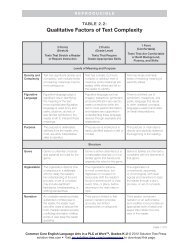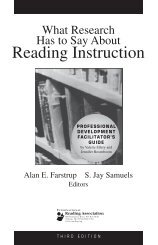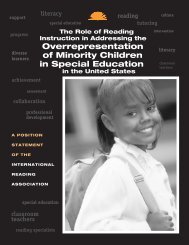Dorothy Strickland - International Reading Association
Dorothy Strickland - International Reading Association
Dorothy Strickland - International Reading Association
Create successful ePaper yourself
Turn your PDF publications into a flip-book with our unique Google optimized e-Paper software.
language supports the belief that the learner’s home language should be valued and accepted as<br />
part of second language acquisition and learning.<br />
This does not deny the fact that the form language takes has economic, social, and<br />
political importance. Nor does it suggest that helping students achieve competence in Standard<br />
English is not an important goal of the school. It does suggest that much of the low achievement<br />
of language-minority students may be pedagogically induced or exacerbated and therefore<br />
amenable to change (Rueda, 1991). Perhaps most important is the need to keep in mind that all<br />
children learn the language to which they have been exposed. The tendency to equate the use of<br />
language other than Standard English with incompetence must be resisted (<strong>Strickland</strong>, Ganske, &<br />
Monroe, 2002).<br />
The intermediate grades provide an excellent time to guide children in an exploration of<br />
various languages and dialects. Preadolescent children are capable of comparing and contrasting<br />
various ways to express ideas, both orally and in writing. They can also begin to make judgments<br />
about when certain forms of language may be more appropriate than others. Expanding<br />
children’s language repertoires to accommodate a wider range of situations and linguistic<br />
capability should be the ultimate goal.<br />
Quality of Instruction<br />
Many researchers have turned their attention to what is increasingly considered to be a key factor<br />
contributing to the achievement gap—the differences in the quality of instruction that students<br />
receive. According to Haycock (2001), rather than focus on poverty and parental education, we<br />
should begin to concentrate on what takes place in the classrooms that minority students attend.<br />
The problems listed by Haycock include the following: students in high-poverty and highminority<br />
schools are not being challenged; minority students are placed in low-level classes with<br />
a curriculum that does not prepare them for college; no provision is made for students who<br />
require more time and instruction to get on grade level; teachers are often not qualified in the<br />
subjects that they teach; schools with 90 percent greater enrollment or minority students have a<br />
high percentage of underqualified teachers than predominantly White schools. Other researchers<br />
(Darling-Hammond & Hudson, 1989; Ferguson & Brown, 1998) have linked teacher quality with<br />
student achievement and called for a look at both teacher quality, and teaching quality.<br />
The Achievement Gap and Standards<br />
All too often, educators tend to deal with complicated problems by rank-ordering the issues and<br />
dealing with them one at a time. The failure to close the achievement gap may be telling us that<br />
such a linear approach is not the best strategy for addressing the achievement gap (Singham,<br />
2003). Indeed, the value of standards, as a critical element in closing the achievement gap, must<br />
be viewed as one important part of a complex web of possible solutions. Following are several<br />
ways that standards can positively influence schools where students are low achievers.<br />
Promoting a Shared Vision<br />
Stability and sense of mission is important in any school community. It is often missing in low-<br />
SES schools. The process of setting standards or aligning local standards with existing state or<br />
nationally generated standards can inspire teachers and administrators to seriously consider their<br />
goals and commitments to students. Viewing standards as part of an overall mission statement<br />
can provide new teachers with a better sense of what the school expects from them and what they<br />
should expect from students. Teachers who have grown accustomed to teaching particular<br />
Copyright © 2005, 2010 by <strong>Dorothy</strong> S. <strong>Strickland</strong> 3
















